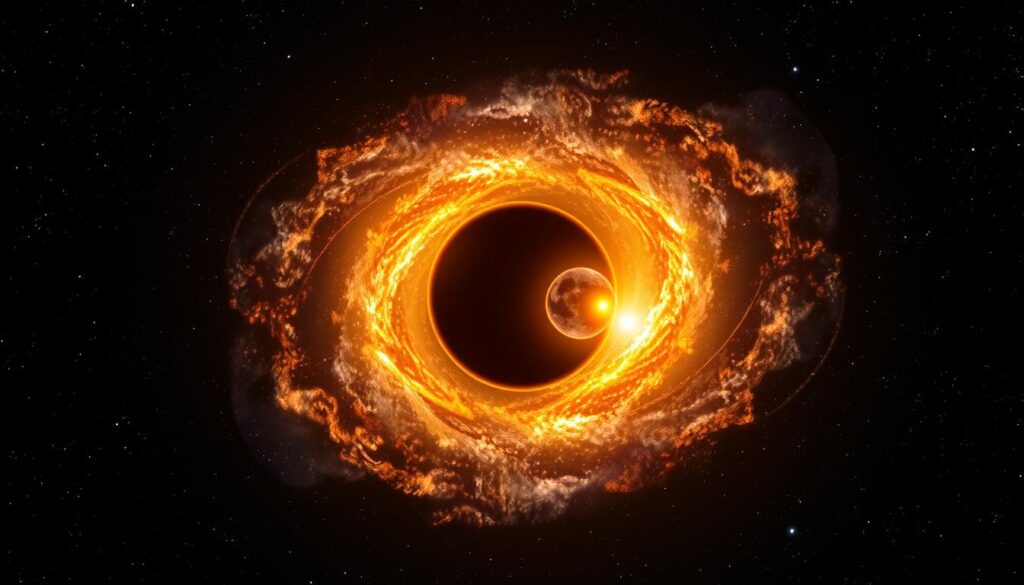
A stunning binary star system with two luminous stars in a cosmic embrace, surrounded by swirling nebulae and vibrant colors, showcasing a dance of light and shadow, distant galaxies twinkling in the background, a dark void of space enhancing the brilliance of the stars.
In the vast universe, stars dance in a cosmic symphony. Binary star systems are especially fascinating. They have two stars orbiting a common center. These pairs have captivated astronomers and stargazers for a long time.
They give us a peek into how stars evolve and their role in space exploration.
Key Takeaways
- Binary star systems are composed of two stars that revolve around a common center of gravity.
- These cosmic partners provide invaluable insights into stellar formation, evolution, and their potential influence on nearby planetary systems.
- Studying binary star systems helps advance our understanding of the universe and can contribute to future space exploration efforts.
- The complex interplay between the two stars in a binary system offers a unique window into the fundamental laws of physics governing the cosmos.
- Observing and analyzing binary star systems is a crucial aspect of modern astronomy, unlocking secrets about the origins and dynamics of stellar structures.
What is a Binary Star System?
A binary star system is when two stars orbit around a common center. These stars can be different in size, mass, and brightness. They create a beautiful dance in the galaxy.
Imagine looking up at the night sky and seeing two stars so close together that they appear as one. In reality, some stars are actually part of a system where two stars orbit each other. This kind of star system is known as a binary star system.
Understanding Binary Star Systems
A binary star system consists of two stars that are gravitationally bound to each other. These stars orbit a common center of mass. This means they circle around a shared point due to their mutual gravitational attraction. Here’s a closer look at the key aspects of binary star systems:
Types of Binary Star Systems
Binary star systems can be classified into different types based on how we observe them:
- Visual Binaries: These are systems where the two stars are far enough apart that we can see both stars individually through a telescope. They appear as distinct points of light in the sky.
- Spectroscopic Binaries: These stars are so close together that they appear as a single point of light. However, their binary nature is detected by observing the Doppler shifts in their spectral lines, which indicates that the stars are orbiting each other.
- Eclipsing Binaries: In these systems, the orbital plane of the stars is aligned in such a way that, from our point of view, one star periodically passes in front of the other, causing the system’s brightness to vary. This periodic dimming is what reveals the presence of the binary system.
- Astrometric Binaries: Here, the presence of a companion star is inferred from the observed motion of the primary star. The secondary star is not visible directly, but its gravitational influence on the primary star can be detected.
Why Binary Star Systems Matter
Binary star systems are important for several reasons:
- Measuring Stellar Masses: By studying binary systems, especially those with well-defined orbits, astronomers can calculate the masses of stars. This is because the gravitational pull between the stars affects their orbits, and this information can be used to determine their masses with great accuracy.
- Understanding Stellar Evolution: Binary systems provide insights into how stars evolve. For example, interactions between binary stars can lead to phenomena such as nova eruptions or even supernovae, which help scientists learn more about stellar lifecycles.
- Testing Theories of Stellar Physics: Binary stars serve as natural laboratories for testing theories about stellar structure and dynamics, helping to refine models of how stars work.
Key Takeaways
- Binary Star Systems: Consist of two stars orbiting each other due to their mutual gravitational attraction.
- Types: Include visual binaries, spectroscopic binaries, eclipsing binaries, and astrometric binaries.
- Significance: Essential for measuring stellar masses, understanding stellar evolution, and testing theories of stellar physics.
Conclusion
Binary star systems are fascinating cosmic pairings that offer a wealth of information about the universe. By studying these systems, astronomers can uncover details about stellar behavior, measure star masses, and gain insights into the lifecycle of stars.
FAQs of What is a Binary Star System?
How can I observe a binary star system?
Some binary star systems can be observed with a telescope, especially visual binaries. For others, like spectroscopic binaries, advanced techniques such as spectroscopy are used.
What causes the brightness changes in eclipsing binaries?
The brightness changes occur because one star passes in front of the other from our perspective, blocking some of the light and causing the system’s overall brightness to decrease periodically.
Can binary star systems affect each other?
Yes, they can. The gravitational interaction between the two stars can lead to various phenomena, including tidal forces that might affect their structure and evolution.
Are binary star systems common?
Yes, binary star systems are quite common. In fact, many of the stars you see in the night sky are part of binary or multiple star systems.
Defining the Cosmic Duo
The stars in a binary system are called the “binary star components.” They can be similar or very different. This range shows how complex and rich these pairs are.
Formation and Evolution
Binary star systems form in many ways, like from a cloud fragment or star capture. Over time, they can show amazing things like mass transfer and stellar mergers. The binary star lifecycle shows how these pairs change and grow.
| Binary Star System | Definition | Components | Formation Process | Evolutionary Stages |
|---|---|---|---|---|
| A system of two stars that revolve around a common center of gravity | Gravitationally bound stellar companions | Primary and secondary stars of varying sizes, masses, and luminosities | Fragmentation of parent molecular cloud, capture of one star by another | Mass transfer, stellar mergers, exotic object formation (pulsars, black holes) |
“The dance of the binary stars is a captivating display of celestial forces, revealing the dynamic and ever-evolving nature of our universe.”
Binary Star System: The Cosmic Dance

A mesmerizing binary star system in deep space, featuring two stars of different sizes and colors orbiting each other in a dynamic dance. Surrounding them is a swirl of cosmic dust and gas, illuminated by their radiant light, creating a captivating celestial backdrop with distant galaxies and nebulae scattered across the vast expanse of the universe.
The dance of binary stars is a mesmerizing cosmic ballet. These two stars orbit around a common center, showing a variety of binary star orbital patterns. This dance is a wonder for astronomers and stargazers.
Binary star systems have different orbital patterns. Some have wide, elliptical orbits that take years or decades. Others have tight, circular paths that complete in days or weeks. This shows the complex gravitational dance between the stars.
The binary star interactions can deeply affect the stars’ evolution. If the stars are close, they may swap material. This can change their brightness, temperature, and even their final state.
Astronomers use binary star classification to group these pairs. They look at their separation, brightness, and spectral types. This helps scientists understand the diverse world of binary star systems.
“The dance of the binary stars is a magnificent display of celestial choreography, revealing the intricate beauty of our universe.”
Binary star systems show the dynamic nature of our cosmos. By studying these pairs, we learn more about stellar evolution. We also get to see the “cosmic dance” in the heavens.
Conclusion
The study of binary star systems is very important. It helps astronomers understand the universe’s complex dance. By studying these pairs, scientists learn about the universe’s formation and behavior.
Research on binary star systems is not just interesting. It also helps with space exploration. Scientists can better predict and model the universe’s complex interactions. This knowledge guides our understanding of the cosmos and future space missions.
The study of binary star systems is growing. New technologies and tools will let scientists explore more. They will uncover new knowledge and make discoveries that change how we see the universe and our place in it.
Important Point
| NO. | Important Points |
| 1. | About Us |
| 2. | Contact Us |
| 3. | Disclaimer |
| 4. | Privacy Policy |
FAQs of Binary star system
What is a binary star system?
A binary star system has two stars orbiting around a common center. These stars can be similar or different in size, mass, and brightness.
How do binary star systems form?
They form in several ways, like when a cloud breaks apart or when one star captures another.
How do the stars in a binary system interact?
The stars in a binary system dance around their common center. Their orbits can be wide and elliptical or tight and circular. This dance affects how each star evolves and the system’s overall features.
How are binary star systems classified?
Astronomers use different systems to classify binary stars. They look at things like how far apart the stars are, how bright they are, and what they look like in the spectrum.
What is the significance of studying binary star systems?
Studying binary star systems is very important for astronomers. They help us understand how stars and systems form and evolve. As we learn more, it will help us understand the universe better and prepare for space travel.
What are some common keywords related to binary star systems?
Keywords include double star, stellar system, space exploration, astronomy, and celestial bodies. Also, binary star formation, lifecycle, dynamics, interactions, and classification are important.
